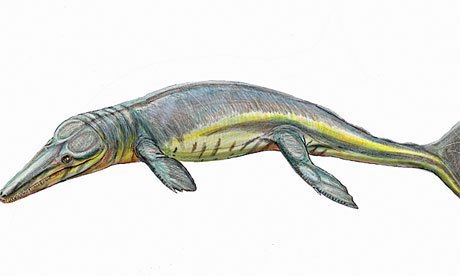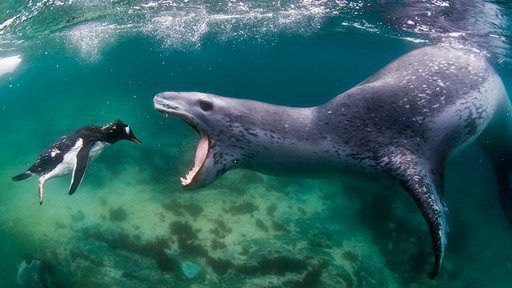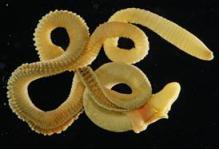Richard Conniff's Blog, page 79
February 5, 2013
Getting Ruff with Pigeons
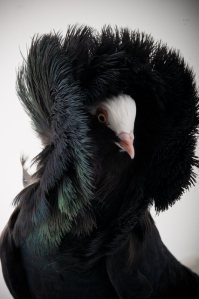
Richard Bailey photographed some of the pigeons breeds that fascinated Darwin
How do breeders develop such colorful and varied pigeons? To find out, the normally reclusive Charles Darwin immersed himself in the hobby, frequenting the taverns and other low abodes where fanciers met and becoming “hand & glove with … Spital-field weavers & all sorts of odd specimens of the Human species, who fancy pigeons.”
Now a University of Utah researcher has taken on the same question more directly, with genetic analysis. He traced the efflorescence of spectacular pigeon head ornamentation to a change to a single gene. Here’s part of the story, from Carl Zimmer’s account in today’s New York Times:
… pigeon breeders produced crests on the birds on five separate occasions. The scientists compared the genomes of the crested pigeons with one another, as well as with other pigeons and with chickens, turkeys and other species. They hunted for mutated genes unique to the crested breeds, and found that all of them shared precisely the same mutation in precisely the same gene, EphB2.
Bird embryos develop placodes, little disks of tissue on their skin from which feathers will grow. The scientists found that in ordinary pigeons without crests, EphB2 became active on the bottom edge of the placodes; in crested pigeons it was active on the top edge.
The experiment suggests that EphB2 tells the placode which way is up. In most pigeons, it instructs the feathers to grow down the neck; but the mutation changes the location where EphB2 switches on, effectively turning the feathers upside down and producing a crest.
“They grow the wrong way,” Dr. Shapiro said. “They’re even pointing the wrong way in the embryo, before they become feathers.”
The new research suggests that the crested version of EphB2 arose in a surprising way. It mutated only once, rather than five separate times.
Dr. Shapiro came to this conclusion in part because he found that it takes two copies of the mutant gene to reverse the feathers. When the mutation arose, it was passed down invisibly from pigeon to pigeon. Only when two carriers happened to mate did they suddenly produce a crested chick.
Along with Zimmer’s text, check out Bailey’s colorful photo series.

February 4, 2013
How to Save a Natural History Museum
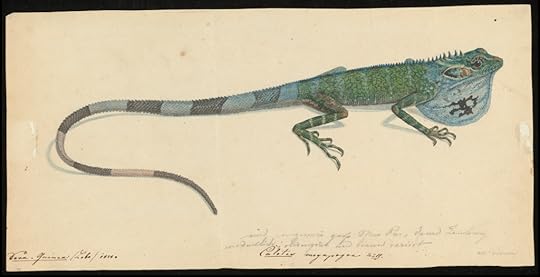
Art from the Dutch Commission explorers in what is now Indonesia
Natural history museums around the world are struggling to survive. Even the celebrated Field Museum in Chicago recently announced a budget cutback targeted mostly at its scientific staff. So this article from the Wall Street Journal caught my attention as I was traveling last week.
The gist of it is that the the Peabody Essex Museum, once a dusty little American history venue in Salem, Mass., decided to change its audience and vastly increase its endowment. The aim was to avoid being caught in the trap of continually chasing short-term funding.
To get that endowment, it transformed itself to find a new audience–the audience, that is, living next door. When Dan L. Monroe became director in the early 1990s, he realized that the museum’s main challenge was to give local residents reason to become repeat, lifelong visitors to the museum.
Natural history museums have the same basic problem. They attract families with young children, and when the children get past second or third grade, the families fade away. The other thing that struck me is that the Salem museum chose to emphasize art and culture over straight history. Though naturalists will hate to think it, art not only brings in bigger repeat audiences, but it has more status appeal than science for the sort of people who might become museum endowment donors.
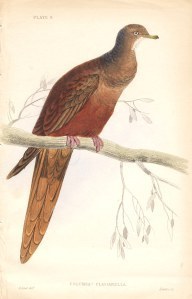
An Edward Lear pigeon
The idea isn’t to cut back on the science or to back off from the primary mission of preserving and documenting life on Earth, but to develop both by taking advantage of neglected strengths: Early naturalists often produced great visual records of what they were seeing–and their drawings and water colors lend themselves to exhibitions. (I know some museums are already doing this sort of thing. But for instance: A show on Audubon and Alexander Wilson, the rival fathers of American ornithology; a show on the pigeon art of Edward Lear, or the mycology of Beatrix Potter; a show on how natural history discovery shaped the entire genre of children’s books.) The discoveries the naturalists brought home also showed up in the great art of the day, particularly in the Netherlands. Finally, as I discuss in my book The Species Seekers, what the naturalists were discovering had a profound effect on poetry, fiction, music, and other cultural endeavors. Staging exhibitions and concerts and plays to celebrate these connections would draw a whole new audience in among the dinosaur skeletons. What about comedy even? British stand-up comic Bill Bailey is, for instance, currently doing a show about Alfred Russel Wallace, the … step-father of evolutionary theory.
Here’s part of the Wall Street Journal story:
… conventional wisdom in the museum world dictates that raising endowment money is too tough to tackle. “It’s a self-supported vicious circle that we have gotten ourselves into as a field,” Mr. Monroe says, “that people will only give to a new building where they can put their name on it.” When annual contributions come up short, both museum staffers and trustees tend to look first at ways to increase earned income—raising the price of admission; staging blockbuster exhibitions to draw more visitors; building destination restaurants; renting out event spaces and “renting” works from their permanent collections to other museums. Some have taken to consulting on art for airports and hotels, offering website-design advice to their peers, and talking about developing apps to sell to visitors—in vast numbers, of course.
The Peabody Essex is doing some of those things, too, but as Joshua Basseches, PEM’s deputy director and chief operating officer, who was invited by Mr. Monroe to join our lunch in the museum’s restaurant, says, “To dramatically increase earned revenue from sources other than admissions and retail is hard to do.”
Mr. Monroe says that the Peabody Essex has been able to go its own way because it has tightly linked its financial game plan with the museum’s strategy, which is founded on insights that date to the 1990s. Salem is a historic town, and the museum used to depend on attracting 65% of its audience from tourists and 35% from the local population. By the time Mr. Monroe arrived, however, historic sites were losing their appeal to Americans. The Peabody Essex decided to stress art and culture, instead of history, and to reverse its visitor targets: 35% should be tourists and 65% should come from the area. “That gives you a dynamic relationship with the community and the capability to develop a support base,” Mr. Monroe says.
To draw more local visitors, the museum had to turn them into repeat visitors. So, over the years, its collections have evolved to include more art, its programs to offer more changing exhibitions, and its buildings expanded twice to provide more space for galleries, programs, a bigger gift shop, a glass-enclosed atrium where visitors may rest their eyes between gallery visits, and so on. Annual attendance is now about 250,000, double the total in 2002, before the last expansion.
Mr. Monroe still talks a lot about “improving the visitor experience”—now the subject of a regular survey—and advancing the museum’s mission, which has also evolved. It now includes a line that he believes is a key to its fundraising success: “Through its exhibitions, programs, publications, media and related activities, PEM strives to create experiences that transform people’s lives by broadening their perspectives, attitudes, and knowledge of themselves and the wider world.”
Donors, Mr. Monroe says, have been receptive to the idea that it’s far more important to have an impact on people’s lives than it is to put their name on a building. His evidence for life-changing experiences is anecdotal—more repeat visits, changing attitudes toward art, and so on. But it’s convincing enough for Mr. Monroe to say, “We raise money around our mission, and not around buildings.”
With that in mind, PEM was also able essentially to flip the proportions of two of the three sources of income. In 2017, earned income will continue to provide about 24% of the budget, but just 18% will have to derive from contributed income, because 58% will come from the endowment. Very few other museums come close to that—with Alice Walton’s Crystal Bridges Museum of American Art being a notable exception. The lucky ones might be striving toward a model that equalizes the share contributed by the three money pots.
Having said all that about natural history museum, I should add an entirely contrary note, from the cheesy but popular British artist Damien Hirst, who has said: “I always thought it would be great if art galleries were more like the Natural History Museum (London), where you go in and there’s this big wow factor, rather than having to ask yourself, ‘What am I supposed to be thinking?’”
Let’s just say that the differing museum categories have a lot to learn from one another.

January 30, 2013
A Reason for Redheads to Live

Fabulous cysteine excreter?
It was just the other day (o.k., September 2011) when one of the world’s largest sperm banks put out the “No Redheads Need Apply” sign.
Except in Ireland, nobody really wanted what they had to offer.
But now a study in Physiological and Biochemical Zoology argues that red hair may in fact confer an evolutionary advantage.
It’s not about Zahavi’s handicap principle–the idea that males in particular demonstrate their might, and win mates, by showing flashy colors and otherwise taking big risks. Instead it has to do with some humble biochemical advantage.
On a personal note, I always thought there was something right about the actress Julianne Moore. I just didn’t realize that it had to do with cysteine excretion. Here’s the report from ScienceDaily:
Red coloration — historically seen as costly in vertebrates — might represent some physiological benefit after all, according to research published in the journal Physiological and Biochemical Zoology.
Pheomelanin, which is responsible for red hair and freckles in humans and orange and chestnut coloration in other animals, is known to increase the damage to skin cells and melanoma risk when present in large amounts. Furthermore, its creation involves the consumption of glutathione, a beneficial antioxidant.

Barn Swallow, Hirundo rustica
In an attempt to unearth the factors favoring the evolution of pheomelanin in spite of its costs, Ismael Galván and Anders P. Møller of the University of Paris-Sud examined the survival from one breeding season to the next of a wild European population of barn swallows, as well as the annual survival rates of 58 species of American birds.
A recent hypothesis claims that the consumption of cysteine (a component of glutathione) that occurs when pheomelanin is produced can be beneficial under conditions of low stress. Cysteine, which is mainly acquired through diet, can be toxic at high levels, so the production of pheomelanin may help to sequester excess quantities of this amino acid.
Galván and Møller measured birds’ blood levels of uric acid and analyzed the coloration of their chestnut throat feathers (an indication of pheomelanin content). When they compared birds that had similar uric acid levels (and therefore similar capacities to excrete excess amino acids), they found that both the European barn swallows and the American birds with larger amounts of pheomelanin in their feathers survived better.
This study is the first to propose that the costs/benefits of pheomelanin may depend on prevailing environmental conditions, and its results suggest that the production of this pigment may even be beneficial in some circumstances. Given that all higher vertebrates, including humans, present pheomelanin in skin, pelage, and plumage, Galván and Møller’s findings increase the scant current knowledge on the physiological consequences of pheomelanin and open new avenues for research that will help us understand the evolution of pigmentation.
Story Source: Ismael Galván, Anders P. Møller. Pheomelanin-Based Plumage Coloration Predicts Survival Rates in Birds. Physiological and Biochemical Zoology, 2013; : 000 DOI: 10.1086/668871


A Contrarian View of Species Discovery
In case you missed it, a paper in this week’s Science takes a contrarian look at the rate at which species are going extinct, the number of species remaining to be discovered, and the availability of expert taxonomists capable of describing them. Here’s part of a report from Rachel Nuwer in The New York Times:
In a paper published in Science, the team delivers good news in three-fold. Taxonomy, or the branch of science concerned with classifying and naming species, is thriving, they write. The number of species left to discover and name are not as daunting as some estimates indicate, they add, and extinction rates are not as bad as conservationists may assume. With these factors in mind, nearly every species on the planet could be discovered within the next 50 years if current trends continue.
“The real crux is that actually we can discover most species before the go extinct,” said Mark Costello, an associate professor at the Leigh Marine Laboratory at the University of Auckland and the paper’s lead author. “Things are not as bad as we thought: there are fewer species than we thought, and efforts to find and name them are greater than we thought.”
Recent biology graduates may recall their freshman professors lamenting the end of the art of taxonomy. In Britain, the House of Lords published a report in 2008 indicating that this old science had reached a “point of crisis.” The demand for taxonomists has declined in North America and Europe, concerned parties warned, and a growing emphasis on biomedical and molecular science is elbowing them out of university departments.
“A couple of decades ago, people in the U.K. and elsewhere were saying taxonomists are going extinct faster than species,” Dr. Costello said. “But this is an old paradigm taken for granted, and nobody checked the numbers.”
Dr. Costello and his colleagues first picked up on this inaccuracy while compiling a global biodiversity database. Much to their surprise, they found that three times as many people were actively identifying new species over the last decade than had done so in earlier years. Quite a few of these people were working from home addresses, suggesting that they are high-level amateurs who pursue taxonomy as a hobby rather than a profession.
Currently, around 16,000 papers announcing new additions to the tree of life come out each year. Most of these findings represent arthropods, the group that dominates global biodiversity and includes crustaceans and insects; mollusk discoveries are also plentiful.
M. J. Costello A close-up of soft coral in the Philippines.
The number of such papers has increased significantly over the last decade, especially in up-and-coming biological hot spots like South America and Asia that house a significant proportion of the globe’s undiscovered biodiversity. “Even if things have stayed the same in the Northern Hemisphere, they’re growing rapidly in the Southern Hemisphere and Asia,” Dr. Costello said. “Maybe older professionals are not aware of all the young people coming up through the system, especially if they’re based in other countries.”
From there, the researchers decided to take a closer look at how many species currently occupy the planet (not including bacteria). We already know of about 1.5 million of them. As for the unknowns, recent past estimates have varied by orders of magnitude, from two million to 100 million. Dr. Costello and his colleagues rounded up the latest papers that combine empirical data, extrapolated rates of discovery and the latest statistical models for terrestrial, marine, arthropod and plant species. Collectively, those papers indicate that two to eight million species have yet to be discovered.
Lastly, the researchers tackled the question of extinction rates. Other papers estimated that one-hundredth of a percentage point to 5 percent of species are going extinct each decade. If scientists assume a worst-case scenario — 5 percent of species lost every 10 years — then half of the planet’s biodiversity will be gone in the next 150 years. “We were quite surprised to find that the extinction numbers being thrown around also vary widely, even more so than the number of species people think are on earth,” Dr. Costello said.
Recent, more realistic estimates indicate a loss of less than 1 percent per decade, however, in which case the rate of finding and describing species would greatly outpace extinction rates. Nailing down this last unknown is tricky, however. The risk of extinction varies between animals, and climate change, habitat destruction and the wildlife trade may exacerbate future extinction trends. What is more, the speed of discovery may slow as the pool of yet-to-be-described species dwindles — like finding that last, well-hidden Easter egg.
Taking all of this into account, Dr. Costello and his colleagues hope that an international community will emerge to coordinate the many shoestring endeavors currently dominating the discoveries. An expenditure of $500 million to $1 billion could provide a 10-fold increase in global taxonomic efforts, they estimated, tidying up all species descriptions by 2060.
All of this may lead one to ask why researchers care so much about discovering and naming species in the first place. As elements are to chemistry and particles are to physics, species are the most basic metric in ecology. “The first thing we want to do when we start exploring a natural environment is name species,” Dr. Costello explained. “Once the species are defined, we have a baseline from which we can then build up more knowledge.”
“And, we’re just a curious species ourselves, so this is all a part of exploring our own world to understand what lives with us,” he said. “It’s a simple way of saying, let’s understand nature.”

January 28, 2013
Sea Monster Discovered
Sorry, to run this back to back with that alarming photo of the leopard seal about to sink its teeth into a penguin. Happily for us, though, this new monster is a fossil, discovered in a Scottish museum–a reminder of the riches such natural history museums still contain. Here’s The Guardian’s account:
A creature resembling a hybrid dolphin and crocodile has been identified by scientists examining fossil remains discovered more than a century ago.
The new species, named Tyrannoneustes lythrodectikos, was a marine “super-predator” that lived 163 million years ago. It belonged to a group of ancient crocodiles with dolphin-like features.
An amateur fossil hunter found the reptile’s partial skeleton in a clay pit near Peterborough in the early 1900s. Experts have only now been able to confirm the identity of the remains, housed at the Hunterian Museum at the University of Glasgow.
The animal had pointed, serrated teeth and a large gaping jaw suited to feeding on large-bodied prey. It represents a transitional form between marine crocodiles that fed on small prey and their supersized relatives.
Dr Mark Young, from the University of Edinburgh, said: “It is satisfying to be able to classify a specimen that has been unexamined for more than 100 years, and doubly so to find that this discovery improves our understanding of the evolution of marine reptiles.”
Dr Neil Clark, palaeontology curator at the Hunterian, said: “Little research has been done on this specimen since it was first listed in 1919. It is comforting to know that new species can still be found in museums as new research is carried out on old collections.
“It is not just the new species that are important, but an increase in our understanding of how life evolved and the variety of life forms that existed 163 million years ago in the warm Jurassic seas around what is now Britain.”

January 26, 2013
Swimming into the Jaws of Death
This is one of the more terrifying photos I have ever seen, made more so because the same thing happened not long ago to a young marine biologist named Kirstie Brown, who was working in Antarctica.
Photographer Amos Nachoun took this photo in Port Lockroy, on the Antarctic Peninsula. You can check out some of Nachoun’s other spectacular photos here.


January 25, 2013
The Fine and Bloody Art of Hedgerows
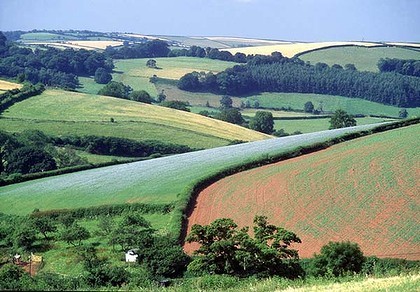
(Photo: Campaign to Protect Rural England)
This is a piece I wrote in England in about 1994. It’s dated in terms of hedgerow destruction, and protection. (You can read an update here. And there are some additional links at the end of the article.) But I’m reprinting it on the hunch that some of the characters I met then are vanished types in the British countryside, and the crofters now probably all have iPhones.
“That’s a good hedge,” the farmer said, walking along a dense field border of hawthorn and beech, somewhere in the north of England. “It’s a grand habitat for things to creep in.” It was October, and the hawthorn were thick with bright red berries that songbirds would harvest over the winter. Here and there, a blackthorn was hung with fat, blue sloe berries. (“Three pounds of sloes, two pounds of sugar, and one bottle of gin,” said the farmer, giving his recipe for sloe gin. “I was telling a fella the other day that it’s three-two-one, and he said, ‘What, three bottles of gin?”) There were rosehips that moth caterpillars had mined out for sustenance, and others, still intact, that field mice would climb up to strip bare for seeds in the middle of February.
Britain’s hedgerows are, in truth, an excellent place for things to creep in, a long, thin bramble-and-thorn habitat. They are living fences populated by a Wind in the Willows community of moles, voles, badgers, weasels, and shrews. Roughly 60 bird species nest or feed in hedges, including white throats and black caps up from Africa for the summer, and redwings down for the winter from Scandinavia. So do hundreds of invertebrate species. Bats roost in tree hollows by day and cruise the hedgerows for dinner by night. Hedgehogs, despite their name, generally prefer household gardens. But hedge sparrows are commonplace in hedges, making mossy nests full of beautiful pale blue eggs. Indeed, for many species, hedges are the only available habitat.
“There is no natural habitat left in the United Kingdom,” says Colin Barr, who oversees a nationwide “countryside survey” for the Institute of Terrestrial Ecology. “There is some semi-natural habitat, meaning little or no current interference by man–for instance, the sub-arctic plateau in Scotland.” But the forests in many upland areas are actually government-sponsored plantations–often little more than tree farms. And in the intensively-farmed lowlands, hedges and a few stream borders are the only habitat–indeed, often the only vegetation that hasn’t been plowed flat. “So it follows,” says Barr, “that hedges are seen as particularly important.”
But hedgerows have always been a sort of shadow habitat, a habitat almost by accident. They existed in the first place because farmers needed them, perhaps as far back as the Bronze Age more than 5000 years ago, to separate and shelter their livestock. Hedgerows divided the countryside into a patchwork of small fields, creating a landscape that the poet Andrew Marvell once called “the garden of the world.” But when farmers no longer needed the hedgerows, in the decades after World War II, they began to disappear. Intensive modern agriculture enabled many farmers to replace pastures with crops, and large agricultural machinery made small hedged fields impractical. Even on farms that stayed with livestock, barbed wire was cheaper and required less labor than keeping up a hedge. So where there were 500,000 miles of hedgerow in the mid-1940s, only 240,000 miles (400,000 km) survive today. Until the late 1980s, the government actually paid farmers a subsidy to tear out their hedges.
You can see the results all over the modern British countryside. Driving through the Midlands, you pass hedges that have gone gappy and toothless with neglect, and others that have grown up into a scraggly row of trees. Elsewhere, the fields run for miles without hedges and the crops are separated from the traffic by just five feet of grass. The rolling, unbroken fields, the post-and-barbed wire fences, the radio towers blinking, could just as easily be in Iowa as in England. The neatly cropped, carefully tended hedgerows that were once the bones and marrow of the British landscape have largely vanished.
With the decline in hedges, farmland birds have also decreased in number and range, among them the grey partridge, song thrush, linnet, bullfinch, and corn bunting. Even where hedges survive, the methods now used to maintain them can sometimes reduce their value to wildlife. A butterfly named the brown hairstreak, for instance, comes out late in the autumn, and lays its white eggs in the new growth of blackthorn shrubs. But landowners often root out blackthorn from their hedges because it tends to colonize adjacent fields. And when modern farmers trim a hedge every other year or so, they generally use a tractor attachment called a flail, a sort of airborne rotary lawnmower. The flail takes out most new growth, and the butterfly eggs with it. Despite conservation efforts by volunteer groups around England, the brown hairstreak has suffered a dramatic decline. It’s an unspectacular butterfly with a two-inch wingspan, “a medium brown job,” says an entomologist. But it’s also a piece of the ecosystem, no more, no less, and no one really knows what other species are affected by its disappearance.
“It’s hard to pinpoint species which are totally dependent on hedges,” says Nigel Boatman of the Game Conservancy. Only one species, a plant called the plymouth pear, is reportedly found only in hedges. Most plants and wildlife have evolved in woodland or scrub habitat, then shifted to hedgerows when their native habitat disappeared. But Boatman adds that the continuing disappearance of hedges could considerably reduce numbers of some species and fragment the remaining population. “This could lead to extinction, especially for species which are already local in distribution.”
The value of hedges as a wildlife resource and as a part of the national heritage is now widely accepted in Britain–though not necessarily protected. “In Cambridgeshire, I know of a particularly lovely hedge, called Judith’s Hedge, that is older than Salisbury Cathedral … older than all but a handful of buildings in Britain,” Bill Bryson writes in his book, Notes from a Small Island. The hedge was planted at the behest of William the Conqueror’s niece, for whom it is named. Bryson laments that no law exists to protect such hedges from road-widening schemes or the whim of some brainless owner, who could “bulldoze away 900 years of living history” in a couple of hours.
In fact, Britain’s department of the environment is currently developing just such a law, so that farmers would have to seek permission to remove a designated hedge, much as they might for a historic building. But so many hedges would be protected under the proposed criteria of age, diversity, or as corridors to woodlands, that farmers would have rioted. So the agency is now seeking to develop new criteria that would protect, at most, 8 or 10 percent of all hedges.
As a more palatable way of getting farmers to value their hedges, the government in 1989 reversed its old policy and now pays subsidies for planting and maintaining hedges. As a result, more miles of new hedgerow get planted each year than get pulled out. But the Institute for Terrestrial Ecology estimates that Britain still suffers a net loss of about 11,000 miles of hedgerow each year, because of neglect.
When you see what maintaining hedges actually involves, you begin to understand why farmers neglect them. In addition to regular trimming,, a hedge also needs to be cut down almost to ground level every 15 or 20 years. The old growth remains attached to the root by a thin strap of bark, and gets laid over parallel to the ground along the length of the hedge and woven into a thick living fence. But the skilled field hands who used to do the hedge-laying have mostly departed from the countryside, replaced by machinery.
A few traditionalists keep the art of hedging alive, especially in hilly, less developed areas like Wales and the southwest of England. Each region has its own style of hedging, and also its own language: The tall, wrist-thick shoots that get cut halfway through and laid over horizontally are called “liggans” in one part of England, and “splashers” in another. The stakes that get driven in to hold the laid-over shoots together are called “stakes” in some places and “stabbers” in others. Some areas plant their stakes on alternate sides of the hedge, others drive them into the middle and braid them together with vines, so a cow can’t get her nose under and life the whole hedge into the air. Each region’s hedgers naturally regard their own technique as best, and mildly disparage alternatives. “It doesn’t look right,” they say, and then they add some diplomatic phrase like, “You can understand why they do it,” by which they generally mean the opposite.

Hedge laid in Midland style
But the basic approach to hedging is the same everywhere. First, the hedger clears out the brambles, deadwood, and other undesirables, leaving only healthy hardwood, which is mostly hawthorn. “When you get your thorn,” said Chuck Mason, a dairy farmer in Cumbria, using the local term for the upright shoot, “you cut in at an angle, and it splits down into the ground.” A thin piece of living tissue remains intact to feed the shoot after it is laid over, so it will continue to produce new growth. “Your new shoots come up from ground level. You don’t want ‘em coming from a foot or so in the air, or your sheep and little lambs will dart under.” A shaggy, overgrown hedge perhaps 15 feet high ends up as a thickly-woven waist-high fence. It is almost the exact technique described by Julius Caesar, who encountered hedges on the French-Belgian border 2000 years ago and wrote that they were “impossible to penetrate.” He thought the local tribesmen erected them primarily to discourage the neighbors from looting and pillaging.
Even if the intent is peaceable, hedging often involves bloodshed. “These want to bite,” said Frank Wear, indicating the sharp thorns in a typical hedge. “You’re bound to get a cut of some description. You’re bound to see blood flyin’, and you ignore that. Everybody gets cut.”
Wear is chairman of the Wrington and Burrington Hedging Society in Somerset, a group of West Country crofters like himself devoted to preserving old methods. (“You know what a crofter is?” he asked. “Keeps a few old hens and a few old cows and loses money, that’s a crofter.”) He has been hedging for somewhere over 50 years. (I’m as old as my little finger,” he said, “but a bit older than me teeth.”) When Jon Marshall, a hedge ecologist at Bristol University’s Long Ashton research station, first approached him, Wear said he was not enough of an expert to talk about hedging. But he agreed to meet in the capacity of country bumpkin. (“I can do that,” he said.) He showed Marshall the tools of his trade–a long-handled staff hook, or slasher, for trimming high foliage, a reap hook, like a sickle, for cutting grass and briars in front of the hedge, a variety of billhooks, like short, curved machetes, and a small axe.
“The art of hedging is a lot like anything else,” he said, “you must have sharp tools and nice thick gloves.” He held up a heavy leather mitten for the left hand. “It’ll take a helluva bash with the hook,” he said. But the salvation of modern hedging, he added, is the chainsaw. He showed us a foot-thick hawthorn tree that he had cut with a chainsaw and laid over into a hedge, cutting it again three more times along its fifteen-foot length, to keep it low to the ground, all in a matter of minutes. “When you had to cut something like that with an ax,” he said, “it did try your system for a day or two.”
Wear’s career with the hedging society reflects the revival of British interest in hedges. When he took over in the mid-1970′s, the few remaining members of the society were ready to give it up, but Wear persuaded them to hang on for a year or two until they’d held their 150th annual competition, “and then we’ll bloody well make it or break it.” The hedge-laying competition soon began to make money, attracting newcomers interested in hedges as wildlife havens and as features of the traditional landscape. Wear now teaches a hedging course not just for farmers’ sons, but for accountants and bank managers who’ve bought a house in the country. “Some of them don’t know the difference between a thorn and a briar,” he complains. The first day I say, ‘It’s a pity your mother never drowned you.’ I say that the first day, and they get used to me.” Some students are only interested in learning how to lay the hedge in their back garden, but others wade into the bloody fray of the hedging competitions, in which each competitor lays 11 yards of hedge over five hours, for a first prize of about $40. “One woman came with her lipstick on and her nails varnished and, bugger me if she didn’t win. Beat 20 blokes.”
Marshall asked him how he judged a hedging job. “The cuttin’. A nice clean cut,” said Wear. “The run of the hedge, keeping it all on the same angle. The briars and the holly and all the rubbish out. What we call staking–the stakes down through it. You always make a fence so the sheep can’t get underneath. Because a hedge will always grow up, it’ll never grow down.”
Wear in turn questioned Marshall about the agricultural advantages and disadvantages of different hedge types. Back when the hedges were all being grubbed out, farmers typically regarded them not merely as an impediment to tractors, but as a haven for weeds and insect pests. Marshall’s research helped him to allay these fears. The most common hedge plants are hardwood perennials poorly adapted for colonizing nearby fields, said Marshall. A handful of annuals around hedges can contribute to weed problems, especially if a farmer cultivates right to the edge of the field and sprays herbicides around the hedge base. But if, instead, the farmer simply leaves a thin grassy border along the edge, then what Marshall calls “plant nasties” have no place to germinate. The natural border also becomes an attractive breeding site for game birds like pheasant and partridge, an important source of winter income for many farmers.
Hedges do harbor insect pests like aphids, Marshall said. These pests adapt quickly to any threat, and they are inevitably one step ahead of the farmer’s chemical control methods. But researchers have noticed that hedges are also home to an army of beneficial insects, including predatory beetles and parasitoid wasps, said Marshall. The idea in “integrated pest management,” which is drawing increased interest among farmers, is to reduce levels of pesticide and use the hedges to supply a pest’s natural enemies, Aphids, for instance, are miraculously well adapted to attack a new crop. They practice parthenogenesis–literally virgin birth, without mating–and their offspring, born live, already contain the next generation of offspring developing within them, like Russian dolls. They can produce a new generation every two or three days. But a parasitoid wasp in the hedge is capable of attacking the aphids early in the spring, when each aphid killed eliminates “whole future sections of the population.” Marshall showed Wear a hedge where a colleague has hung traps to find out what kinds of insects overwinter in the hedge, and which type of hedge management works best for beneficial insects. Fields of crops are ecologically unstable, he said, and they may need the semi-natural area of the hedge as a balance. In one German study, the most productive farm was one with hedgerows at roughly 100-yard intervals–precisely the “garden of the world” landscape that farmers diligently maintained in the unenlightened past.
Wear and Marshall drove home along a winding road, where the hedges joined to form a tunnel overhead and you could reach out either window of the car and get bitten by hawthorn. Marshall wondered why the old hedges are so seldom straight: “When they planted the hedges they got paid by the yard,” Wear joked, “and they made them crooked to get more yards in.”
It was surely not the fastest road for getting from one place to another, nor was it the sort of landscape preferred by modern industrial farmers with big tractors and a blinkered, bottom line worldview. Hedgerows are an inconvenience in the get-ahead world of modern Britain. But they are unmistakably British. And it isn’t just a way of life, or a vast community of wildlife that depends on the preservation of the hedgerows, Marshall suggested, but perhaps ultimately the survival of the farmers themselves.
END
For more current information, here’s a link to the English Hedgerow Trust and one to the British National Hedgelaying Society


January 24, 2013
The Ecology of the Invisible
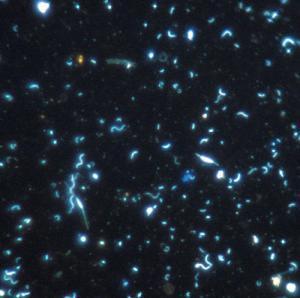 As a writer about the natural world, I never had much interest in microbes. I preferred creatures with teeth and claws and tarsi. But I am getting excited about them now, as scientists find new ways to look into the strange ecology of bacteria, fungi, and viruses. Here’s the latest instance, from Monterey Bay Aquarium:
As a writer about the natural world, I never had much interest in microbes. I preferred creatures with teeth and claws and tarsi. But I am getting excited about them now, as scientists find new ways to look into the strange ecology of bacteria, fungi, and viruses. Here’s the latest instance, from Monterey Bay Aquarium:
Microbiologists who study wild marine microbes, as opposed to the lab-grown variety, face enormous challenges in getting a clear picture of the daily activities of their subjects. But a team of scientists from MIT and the Monterey Bay Aquarium Research Institute recently figured out how to make the equivalent of a nature film, showing the simultaneous activities of many coexisting species in their native habitat over time.
Instead of making a movie, the scientists used a robotic device that dangled below the surface of the ocean, drifting in the water with a neighborhood of microbial populations and gathering samples of one billion microbes every four hours. Similar to fast photography that stops action, the robotic device “fixed” each sample so that whatever genes the microbes were expressing at the moment of capture were preserved for later study in the lab, where the scientists used whole-genome gene-expression analysis to create a time-lapse montage of the daily labors of multiple microbial species over a two-day period.
“A naturalist like Sir David Attenborough can follow a herd of elk and see how the elk’s behavior changes hour to hour, day to day and week to week. But we haven’t been able to observe naturally occurring microbes with that kind of resolution until now,” says Edward DeLong, the Morton and Claire Goulder Family Professor in Environmental Systems in the MIT Department of Civil and Environmental Engineering and Department of Biological Engineering.
DeLong is senior author of a paper on the study appearing online the week of Jan. 21 in the Proceedings of the National Academy of Sciences. Co-authors on the paper are Elizabeth Ottesen, a former MIT postdoc who is now an assistant professor at the University of Georgia; MIT postdoc Curtis Young and research engineer John Eppley; and senior research specialist John Ryan, senior scientist Francisco Chavez, and president Christopher Scholin of the Monterey Bay Aquarium Research Institute.
“We’ve essentially captured a day in the life of these microbes,” DeLong says. “As little as three years ago, I wouldn’t have even have considered it possible to get such a high resolution picture of microbial population dynamics and activity in the ‘real world.’”
Because microbes are extraordinarily sensitive to slight environmental changes and alter their gene expression rapidly in response to fluctuations in temperature, light, nutrient availability and other environmental variables, the genes they express tell a story about their habitat and their interactions with it: In essence, changes in their gene expression provide information on the good times and the bad times they experience. In a sense, each naturally occurring microbe is a living sensor; the researchers read the sensors’ outputs by studying their gene expression.
The montage showed that photosynthetic microbes, which create the oxygen, energy and organic carbon used by the rest of the food web, ramped up their light-utilizing activities in the morning and powered those down at night, just as their domestic brethren do in response to light and dark in the lab.
But the underwater scenes also showed something scientists had never seen before: Nonphotosynthetic, carbon-eating microbes of very different species displayed synchronized, rapidly varying metabolic gene expression. Some of the genes simultaneously expressed by different species shared the same function — for instance, genes associated with growth or respiration. Others encoded very different functions, mirroring the varied metabolic capabilities of the disparate species. The simultaneous expression of these genes indicates that the microbes were responding to similar environmental changes, probably in the nature or quantity of organic matter available in the immediate vicinity.
They all may have been responding to the same cue or possibly one species may have acted as a first responder, signaling other species when it changed its own gene expression.

Rob Knight
“In this work, the scientists use robots on buoys to do the sampling, which allows excellent resolution in both time and space, and they’re therefore able to look at the functions that a range of different types of plankton are expressing,” says Rob Knight, an associate professor of molecular biophysics at the University of Colorado. “The information should be really useful for developing predictive models that help us understand how marine plankton will respond to factors such as climate change and ocean acidification, by revealing the networks by which genes interact with each other to produce complex biological functions.”
The work was funded by grants from the National Science Foundation, the Gordon and Betty Moore Foundation and the Agouron Institute.


January 23, 2013
A Taste for Wormy Acorns

A diet of worms (Photo:Rasbak)
There is no accounting for taste, and a new study from Spain suggests that the small burrowing rodents known as voles actually prefer acorns with a fat, juicy worm inside. For the protein, apparently.
Beware that the press release was written by someone for whom English is a second (or possibly third) language:
Yum
Curious Interaction in Regeneration of Oak Forests: Voles Know Which Acorns Have Insect Larvae
January 22, 2013 — Researchers have observed as voles are able to distinguish the acorns containing insect larvae from those that do not. This fact determines the dispersion and germination of acorns, and therefore the … > full story

January 22, 2013
Bringing Neanderthals Back from the Dead

Kiss me, I’m Neanderthal
George Church, a genetics professor of Harvard School of Medicine, argues that humans could benefit from the resurrection of the Neanderthal, and that he’s the man, or rather, the demiurge, to make it happen.
We killed off that rival species roughly 33,000 years ago. But Church has now extracted enough DNA from fossil bones to clone a Neanderthal baby. The plan would be to splice the Neanderthal genome, or possibly just certain promising pieces of it, onto human stem cells, and implant them in a willing womb. “Now I need an adventurous female human,” he says. The eternal problem of ambitious male scientists.
“We can clone all kinds of mammals,” Church said in an interview with the German magazine Der Spiegel. “So it’s very likely that we could clone a human. Why shouldn’t we be able to do so?”
He adds some caveats about ethics and social consensus. He also describes the technique future geneticists might be able to use, for instance, to bring back a dinosaur species by grafting extinct DNA onto the ostrich genome.
But he also goes off the deep end about neo-Neanderthals: “When the time comes to deal with an epidemic or getting off the planet or whatever, it’s conceivable that their way of thinking could be beneficial.” To give them a social identity, it would be necessary to clone a cohort of Neanderthals. “They could maybe even create a new neo-Neanderthal culture and become a political force.”
Don’t we already have the Tea Party for that?
And finally, a bid to make the idea politically correct: “The main goal is to increase diversity. The one thing that is bad for society is low diversity.”
You will probably not be shocked to learn that Church is promoting his new book, Regenesis: How Synthetic Biology Will Reinvent Nature and Ourselves.
Look for him soon on the “Colbert Report.”



